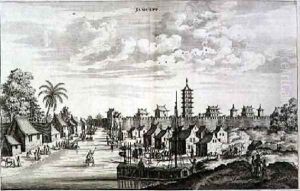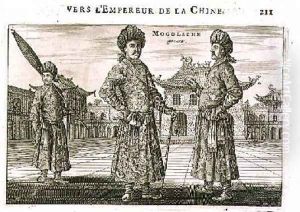





The Porcelain Tower from an account of a Dutch Embassy to China 1665
-
About Reproduction
Discover the allure of art with our faithful reproduction of "The Porcelain Tower from an account of a Dutch Embassy to China 1665", originally brought to life by the talented Jacob van Meurs. Unlike posters or prints, our hand-painted oil painting breathes an unique sense of depth and texture into your space. Every detail, every stroke, and every texture is meticulously recreated, paying the perfect homage to Jacob van Meurs and his artistic vision.
Owning this piece is more than just decoration - it's a statement of your refined taste in art. Let the vibrant colors and intricate details of this replica serve as a daily reminder of the beauty in our world. Elevate your decor and appreciate the richness of art with our replica of this masterpiece.
-
Painting Description
"The Porcelain Tower from an account of a Dutch Embassy to China 1665" is a historical account detailing the observations and experiences of a Dutch diplomatic mission to the Qing Empire in the mid-17th century, as documented by the Dutch engraver and publisher Jacob van Meurs. This work is significant as it provides a European perspective on Chinese culture, architecture, and society during a period when the Qing Dynasty was solidifying its power and the porcelain industry was flourishing.
The account is particularly renowned for its description of the Porcelain Tower of Nanjing, an architectural marvel of the Ming Dynasty, which was highly revered for its design and the use of porcelain in its construction. Van Meurs's depiction of the tower offers valuable insights into the early European encounters with Chinese landmarks and the mutual curiosity between the East and West during the Age of Discovery.
Jacob van Meurs, known for his detailed engravings and illustrations, contributed to the dissemination of knowledge about the distant and exotic lands of Asia through his works. His account of the Dutch Embassy's journey to China in 1665 is a testament to the cross-cultural exchanges that were taking place during a time of increasing global interactions. The work not only captures the aesthetic and cultural significance of the Porcelain Tower but also serves as a historical document that reflects the broader context of European exploration and the beginnings of Sinology.
The Porcelain Tower itself, which was largely destroyed during the Taiping Rebellion in the 19th century, remains a symbol of historical Sino-European relations and the fascination with the "Far East" that characterized much of European intellectual and cultural life during the early modern period. Van Meurs's account, with its detailed engravings, continues to be a valuable resource for historians and art historians interested in the early modern encounters between Europe and China.
-
Lead Time & Shipping
When you order this oil painting replica, it typically takes 2-3 weeks to paint. If the artwork is more complex, it might need a little more time to ensure the best quality. Once it's ready, we'll send you a photo for your approval. After you give the green light, we'll ship it to you for free.
-
Return & Refund
We believe in the quality of our hand-painted oil painting reproductions, and your satisfaction is our priority. If for any reason, you are not completely satisfied with your purchase, we offer a 45-day return policy. You can return your artwork within 45 days of receipt and receive a full refund. Please note that the artwork must be returned in the original packaging and in the same condition as it was received.




















